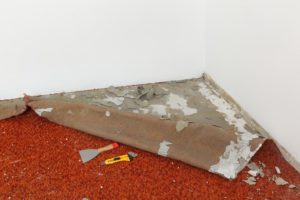Our pre-recorded on-demand CPD “A Specifier’s Guide to Adhesive-free Flooring” explains the key benefits of specifying adhesive-free flooring, namely:
- Waste reduction
- Enhanced design agility
- Operational efficiency
In the first of a three-part series taken from the CPD, we explain the first benefit, waste reduction.
Flooring Waste – The Statistics
Most corporations today have set targets to reduce built environment’s impact on the climate over the next 10 years to make our homes, public and commercial buildings more resource efficient.
Waste reduction plays a key part in reaching those targets, with the construction industry a key contributor to waste in the UK.
According to DEFRA UK Statistics on Waste (Feb 2018), construction, demolition and excavation (CDE) was responsible for 59% of the total 202.8 million tonnes of waste generated in the UK.
And as an example from the workplace sector alone, research from Rype Office suggests that 300 tonnes of fitout goes to landfill every day.
Flooring is very much part of that waste issue, with carpet and Luxury Vinyl Tile in particular, and an area roughly the size of the city of Birmingham is thrown away in carpet every year according to a Changing Markets Foundation report.
Carpet Recycling UK report that of the 400,000 tonnes of carpet disposed of every year in the UK, over half goes to landfill. There is some fantastic work being done to divert waste from landfill by reclaiming and reusing old flooring by organisations such as Carpet Recycling UK and Recofloor, but we still need to do more.
The Issue with Wet Adhesive Flooring Installation
Traditional floor coverings can be notoriously difficult materials to recycle. And even 100% recyclable products can run into difficulties when they are installed using wet adhesives.
This is because on uplift, the floor tile is more likely to be contaminated by not only the adhesive but also residue from the subfloor to which it was adhered, meaning the flooring is not suitable for recovery or reuse and cannot be easily recycled.
For example, the photos below show uplifted flooring contaminated with adhesive residue and installation materials such as underlay left on the backside of the floor covering.

Adhesive contamination on flooring
That potentially 100% recyclable material has been contaminated and becomes a composite material, which is very hard to separate and recycle and so ends up in landfill.

Adhesive contamination on flooring

Photo credit: www.lovelyetc.com
In addition, often the sub-floors such as raised metal access flooring are also contaminated on uplift. The photographs show damage on a metal raised access floor and one to a concrete floor.

Corrosion on raised metal access floor
Significant time, effort and money has to be spent rectifying the damage and preparing the base before the next installation.

Damage to concrete floor
Floors installed without adhesive do not face these problems as both the flooring and sub-floor are left clean and uncontaminated. The floor tiles can be reused or recycled and the sub floor is ready to receive the new flooring with only minimal preparation required.

Re-think flooring!
All too often, floor coverings are seen as single-use items, tending to be changed because a design change is required, rather than when the flooring wears out.
The Contract Flooring Association (CFA) recently published a comprehensive report “Zero Avoidable Waste in Flooring – Towards a Circular Economy” on opportunities for the flooring industry to manage resources more responsibly.
All major flooring types are covered in the report, with carpet tiles in particular described as “engineered to perform well in the harshest commercial locations. Often, their design life of 15 years is well in excess of their fashion-led actual life of 7-10 years. This means a second life is well within their asset lifetime.”
There is an opportunity here for specifiers to design out flooring landfill waste at source by considering the method by which it is installed. By specifying an adhesive free flooring system. flooring becomes a circular material. Its material efficiency is vastly improved by reusing and redeploying it in other areas or even other buildings
IOBAC adhesive-free installation technology makes flooring multiple use, diverting waste from landfill, and enabling flooring to be reused and recycled more effectively than before.
With IOBAC, flooring is transformed into a circular, more flexible design element than ever before.
Check out the rest of Specifier’s Guide Adhesive-Free Flooring CPD to
> discover the other benefits of adhesive-free flooring
> learn about different adhesive-free flooring options
> see case studies of adhesive-free flooring from commercial and residential projects

